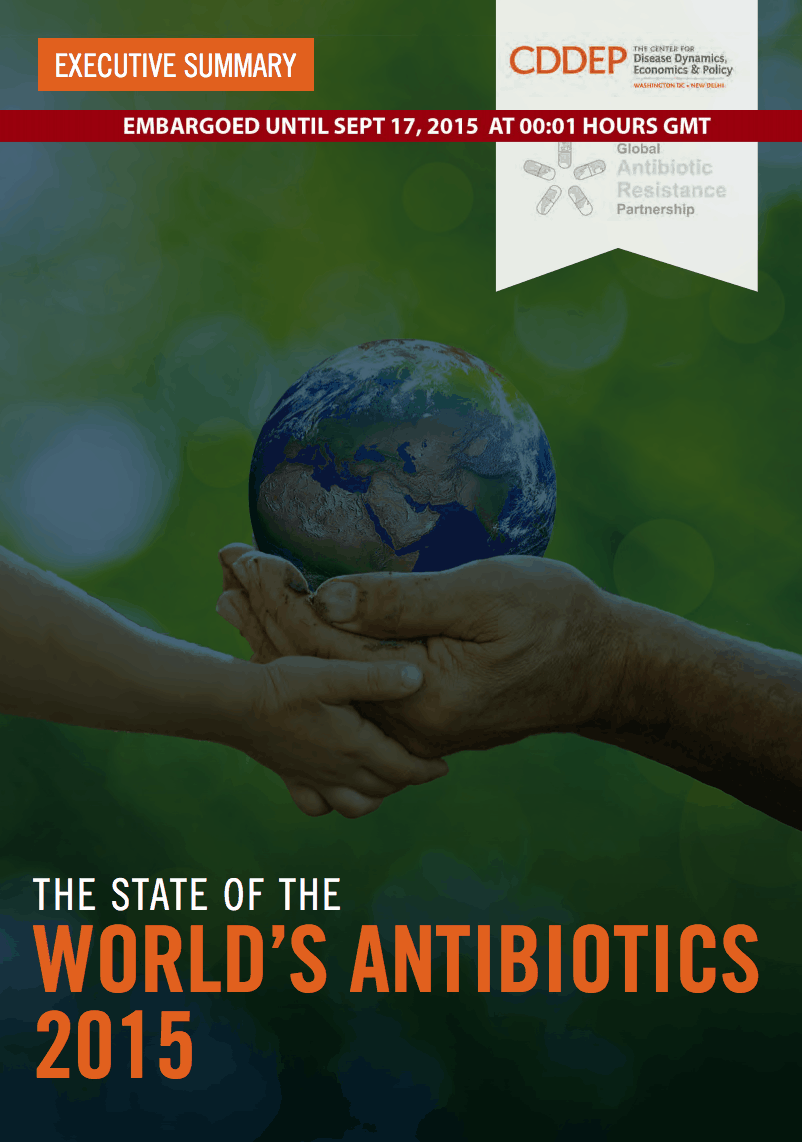September 18, 2015

This week, CDDEP launched two major projects that have been months in the making: The State of the World’s Antibiotics, 2015—a comprehensive report on the status of antibiotic use and resistance around the world—and an expanded, updated and redesigned version of CDDEP’s ResistanceMap. This week’s digest is devoted to the release of these items and other CDDEP updates from the week. Regular updates on drug resistance and global health will resume with next week’s digest.
The State of the World’s Antibiotics, 2015, released yesterday, September 17, provides the most complete picture to date on the status of antibiotic use and resistance around the globe. The report challenges the prevailing argument that the biggest obstacle facing antibiotic resistance is a lack of new drugs in the “antibiotic pipeline.” New antibiotics are part of the solution, but only when coupled with conservation: strong antibiotic stewardship in its broadest sense, which involves limiting overuse of antibiotics in humans and livestock. CDDEP’s Global Antibiotic Resistance Partnership (GARP) of low- and middle-income countries provided both data and insight into the challenges in those countries and how they can be met successfully.
Chapters cover human antibiotic resistance and use, resistance and use in agriculture and the environmental consequences of all use, maintaining the supply of antibiotic effectiveness and what works at the country level to minimize the spread of antibiotic resistance and maximize the positive impact of antibiotics.
The full report and executive summary are available online. Printed copies are available on request (write to [email protected]).
CDDEP’s ResistanceMap has launched the first global collection of maps on antibiotic use and resistance. ResistanceMap is a web-based collection of data visualization tools that allows interactive exploration of antimicrobial resistance (AMR) and antibiotic use trends, now available for 69 countries across the world. Its new iteration, for which the site was completely redesigned and updated, includes never-before-published data on antibiotic resistance in low- and middle-income countries (LMICs), such as India, Kenya, Vietnam, South Africa and Thailand. [ResistanceMap]
Here are some highlights of early coverage of ResistanceMap and The State of the World’s Antibiotics, 2015:
● National Geographic Phenomena: “Antibiotic Resistance Getting Worse Globally, But Fixes Could be Simple”
● Nature: “Dramatic Rise Seen in Antibiotic Use”
● NPR Goats and Soda: “Why is India a Hotbed of Antibiotic Resistance and Sweden is Not”
The GARP-Uganda Working Group launched its situation analysis, Antibiotic Resistance in Uganda: Situation Analysis and Recommendations. The report, which is now available on the CDDEP website, was launched by the working group at a meeting in Kampala on September 15. It details the current state of antibiotic use and resistance in Uganda and culminates in a series of recommendations for combating antibiotic resistance in the country, laying the groundwork for development of a national action plan, as called for by the World Health Organization in its Global Action Plan for Antimicrobial Resistance. The report represents the completion of situation analyses for all eight GARP Phase 1 and 2 countries. [CDDEP]
CDDEP Director Ramanan Laxminarayan has been appointed to the President’s Advisory Council on Combating Antibiotic-Resistant Bacteria (CARB). The Council, which includes nationally-recognized experts on the topic of antibiotic resistance, was created to advise the U.S. Departments of Agriculture, Defense and Health and Human Services on the implementation of the White House’s National Action Plan on Combating Antibiotic-Resistant Bacteria. The Council will hold its inaugural meeting, open to the public, in Washington, D.C., on Tuesday, September 29, 2015. [The White House, U.S. Department of Health and Human Services]
Want to share interesting news via the digest? Email [email protected]











